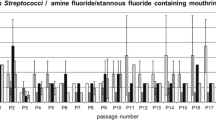Abstract
Methylene blue, at a concentration of 1.0 mg/ml, was able to raise the redox potential (Eh) of pre-reduced culture medium from −288 mV to −154 mV and to poise the medium at an Eh of −171 mV during 48-h incubation in an anaerobic atmosphere. Addition of the dye to suspensions of the anaerobic periodontopathogen,Porphyromonas gingivalis, to give a final concentration of 1.0 mg/ml raised their Eh to −125 mV. During a 24-h period of anaerobic incubation, the dye maintained the Eh at a level (−150 mV) that was more than 200 mV higher than control, dye-free suspensions, and this was accompanied by at least a 6-log reduction in the viable count. The bactericidal effect of the methylene blue could be counteracted by the reducing agent dithiothreitol at a concentration of 2.0 mg/ml, which lowered the Eh to a level (−333 mV) similar to that of controls. These results have demonstrated that the presence of 1.0 mg/ml methylene blue, in its oxidized form, in an environment is inimical to the survival ofP. gingivalis and that this is related, directly or indirectly, to its ability to raise the Eh of the environment. Topical application of methylene blue, or other redox agents, may be an effective means of eliminating this organism from the periodontal pockets of patients with chronic periodontitis.
Similar content being viewed by others
Literature Cited
Aranki A, Syed SS, Kenney EB, Freter R (1969) Isolation of anaerobic bacteria from human gingiva and mouse cecum by means of a simplified glove box procedure. Appl Microbiol 17:568–576
Dobson A, Bullen JJ (1964) A method for the control of Eh and pH during bacterial growth. Hyg Microbiol 35:169–174
Finegold SM (1989) Classification and taxonomy of anaerobes. In: Finegold SM, George WL (eds) Anaerobic infections in humans. San Diego: Academic Press, pp 23–36
Fung DY, Miller RD (1973) Effect of dyes on bacterial growth. Appl Microbiol 25:793–799
Hanke ME, Katz YJ (1943) An electrolytic method for controlling oxidation-reduction potential and its application in the study of anaerobiosis. Arch Biochem Biophys 2:183–200
Hungate RE (1969) A roll tube method for cultivation of strict anaerobes. Methods Microbiol 3B:117–132
Kenney EB, Ash M (1969) Oxidation-reduction potential of developing plaque, periodontal pockets and gingival sulci. J Periodontol 40:630–633
Marounek M, Wallace RJ (1984) Influence of culture Eh on the growth and metabolism of the rumen bacteriaSelenomonas ruminantium, Bacteroides amylophilus, Bacteroides succinogenes andStreptococcus bovis in batch culture. J Gen Microbiol 130:223–229
Marsh P, Martin M (1984) Oral microbiology, 2nd edn, Woking: Van Nostrand Reinhold, pp 5–7
Moore WEC, Holdeman LV, Smibert RM, Hash DE, Burmeister JA, Ranney RR (1982) Bacteriology of severe periodontitis in young adult humans. Infect Immun 38:1137–1148
Morris JG (1980) Oxygen tolerance/intolerance of anaerobic bacteria. In: Gottschalk G, Pennig N, Werner H (eds) Anaerobes and anaerobic infections. New York: Gustav Fischer Verlag, pp 7–15
Morris JG, O'Brien RW (1971) Oxygen and clostridia: a review. In: Barker AN, Gould GW, Wolf J (eds) Spore research. London: Academic Press, pp 1–37
O'Brien RW, Weitzman PDJ, Morris JG (1970) Oxidation of a variety of natural electron donors by the thiol-oxidising agent, diamide. FEBS Lett 10:343–345
Slots J, Genco RJ (1984) Black-pigmentedBacteroides species,Capnocytophaga species andActinobacillus actinomy-cetemcomitans in human periodontal disease: virulence factors in colonization, survival and tissue destruction. J Dent Res 63:412–421
Slots J, Listgarten MA (1988)Bacteroides gingivalis, Bacteroides intermedius andActinobacillus actinomycetemcomitans in human periodontal diseases. J Clin Periodontol 15:85–93
Smith LDS, Williams BL (1984) The pathogenic anaerobic bacteria, 3rd edn. Springfield, Illinois: Thomas, pp 12–17
Socransky SS, Loesche WJ, Hubersak C, Macdonald JB (1964) Dependency ofTreponema microdentium on other oral organisms for isobutyrate, polyamines and a controlled oxidation-reduction potential.J. Bacteriol, 88:200–209
Walden WC, Hentges DJ (1975) Differential effects of oxygen and oxidation-reduction potential on the multiplication of three species of anaerobic intestinal bacteria. Appl Microbiol 30:781–785
Wilson M, Gibson M, Strahan D, Harvey W (1992) A preliminary evaluation of the use of a redox agent in the treatment of chronic periodontitis. J Periodont Res 27:522–527
Author information
Authors and Affiliations
Rights and permissions
About this article
Cite this article
Fletcher, J.M., Wilson, M. The effect of a redox agent, methylene blue, on the survival ofPorphyromonas gingivalis in vitro. Current Microbiology 26, 85–90 (1993). https://doi.org/10.1007/BF01577341
Issue Date:
DOI: https://doi.org/10.1007/BF01577341




